Nicole schreibt...
Vietnam 2010 |
 |
Stop-Over 1: Seoul, South Korea

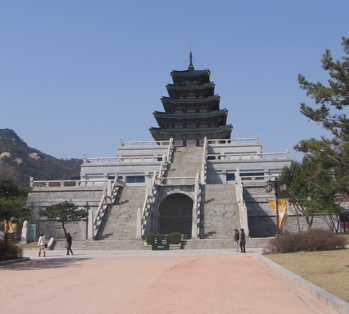 Here I was finally heading for my beloved Asia again, this time to fufill that longstanding wish to visit Vietnam and Cambodia's Angkor Wat. But my first stop would be quite somewhere else - South Korea's capital Seoul, since it was Korean Asiana Airlines who had made me the best offer on the flights I wanted and I had a seven hour layover in Seoul. Even better, when I checked in in Frankfurt, I got a voucher for a four hour-city tour and didn't need to hassle with public bussses and so on (ironically, despite Incheon Airport being celebrated as one of the best airports in the world, the connection to the city is still lousy). There was only one other person interested in the transit tour, a German girl booked on the same flights as myself, slightly younger than me who had the Amelie-look down pat from the 50's Parisian hair cut and make up to the silky gloves and coat. It looked stunning but to doll up like that for two long flights baffles me. We decided to fork out $20 to do the Seoul transit tour with just the two of us and a guide, a sweet Korean called Michelle.
Here I was finally heading for my beloved Asia again, this time to fufill that longstanding wish to visit Vietnam and Cambodia's Angkor Wat. But my first stop would be quite somewhere else - South Korea's capital Seoul, since it was Korean Asiana Airlines who had made me the best offer on the flights I wanted and I had a seven hour layover in Seoul. Even better, when I checked in in Frankfurt, I got a voucher for a four hour-city tour and didn't need to hassle with public bussses and so on (ironically, despite Incheon Airport being celebrated as one of the best airports in the world, the connection to the city is still lousy). There was only one other person interested in the transit tour, a German girl booked on the same flights as myself, slightly younger than me who had the Amelie-look down pat from the 50's Parisian hair cut and make up to the silky gloves and coat. It looked stunning but to doll up like that for two long flights baffles me. We decided to fork out $20 to do the Seoul transit tour with just the two of us and a guide, a sweet Korean called Michelle.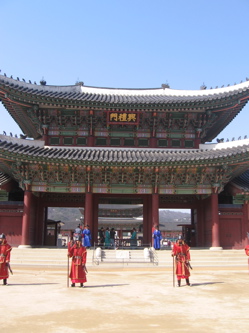 We headed to Gyeongbokgung Palace first, one of the royal palaces of Korea's Joseon Dynasty, which I had wanted to see most of all. The original palace dating from 14th century had been razed by the Japanese who occupied Korea in early 20th century and it's being painstakingly reconstructured now. But while it did have this "fake" vibe to it, much like the royal palace in Burma's Mandalay, it was also nice to see a traditional Asian palace in its full glory and color, including palace guards dressed up in historical uniform.
We headed to Gyeongbokgung Palace first, one of the royal palaces of Korea's Joseon Dynasty, which I had wanted to see most of all. The original palace dating from 14th century had been razed by the Japanese who occupied Korea in early 20th century and it's being painstakingly reconstructured now. But while it did have this "fake" vibe to it, much like the royal palace in Burma's Mandalay, it was also nice to see a traditional Asian palace in its full glory and color, including palace guards dressed up in historical uniform. After the tour we were taken for a walk down Insa-dong, supposedly a street of "Ancient Korean handicraft" but more like the usual tourist drag for souvenirs. Lastly we went along the newly revamped stream where Seoul comes out to party in the evenings and stopped by a little market, where Michelle made us taste all sorts of stuff (and I do not want to know what half of it was, nor am I sure I want to know. Koreans are generally very sweet, friendly people but the stuff they chow down beggars belief half the time). Then it was back to Incheon and while it was certainly not enough to really see Seoul, I was glad to have got this little glimpse into a place I would normally never have considered visiting. Amelie and I stayed together at the airport and had a meal, then finally said goodbye after arriving in Hanoi after the longest flight ever. Or well, second-longest, for nothing can beat how crappy I had felt on the flight from Charlotte to San Francisco. Following a long-distance flight with another fairly long flight is just murder and I'm too exhausted to even consider sleeping.
Vietnam

So I finally got to Hanoi in the late evening and... no one was waiting for me at Noi Bai Airport despite having arranged pick-up with the hotel. Duh. The nice people at the tourist information even tried to contact the hotel for me to ask for my pick up and supposedly he was on the way, but when he failed to materialize after another 30mins, I decided to fork out for a taxi. The old quarter of Hanoi was deserted when we got there just after midnight and the hotel seemed shuttered, but a guy on night duty let me in - only to tell me that I had to stay at their sister hotel as they were full (supposedly that also explained the lack of pick up). After an eerie but great motorbike ride through the deserted dark streets (with the driver looking like 12 years old), I finally got to be where I wanted and dropped dead into my lovely big bed.
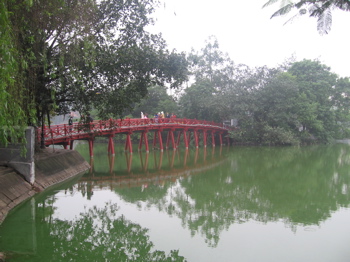 |
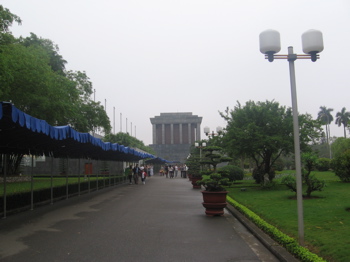 |
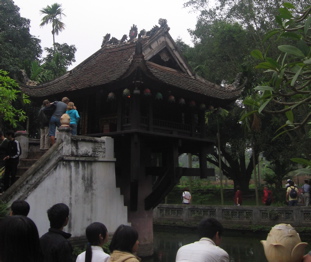 |
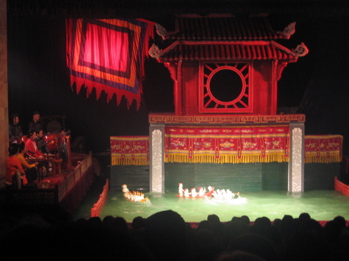 |
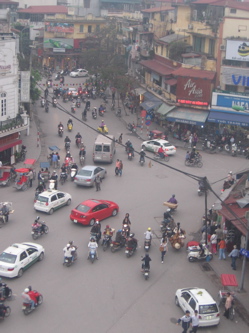 In the afternoon I headed out again for that other big Hanoi tourist to-do, the water puppet theatre. Apparently it was invented by farmers in the North who let their puppets dance while knee-deep in water in the rice fields. It was pretty interesting to see - well, what I saw of it, I must admit, because I dozed off once or twice and I sure wasn't the only jetlagged tourist to do so! Afterwards I went for dinner at the lovely City View cafe on the fifth floor of a building overlooking the crazy traffic down below, a fascinating spectacle I could watch for hours. And yes, it IS a bit daunting to throw yourself into the mayhem on the street, but oddly enough it all works - as long as you don't stop and fret, the armies of motorbikers will just navigate around you (and even around old ladies shuffling around with those heavily loaded scales-like transport things).While I needed an early night in to fully recover from the long trip and jetlag, I already loved just being back in Asia.
In the afternoon I headed out again for that other big Hanoi tourist to-do, the water puppet theatre. Apparently it was invented by farmers in the North who let their puppets dance while knee-deep in water in the rice fields. It was pretty interesting to see - well, what I saw of it, I must admit, because I dozed off once or twice and I sure wasn't the only jetlagged tourist to do so! Afterwards I went for dinner at the lovely City View cafe on the fifth floor of a building overlooking the crazy traffic down below, a fascinating spectacle I could watch for hours. And yes, it IS a bit daunting to throw yourself into the mayhem on the street, but oddly enough it all works - as long as you don't stop and fret, the armies of motorbikers will just navigate around you (and even around old ladies shuffling around with those heavily loaded scales-like transport things).While I needed an early night in to fully recover from the long trip and jetlag, I already loved just being back in Asia.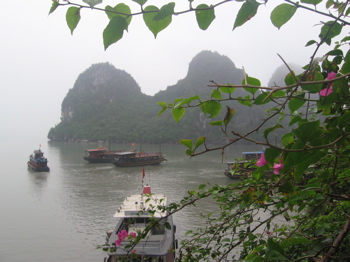
Halong Bay is on everyone's Vietnam itiniary, so naturally it was on mine too, with day trips being offered from Hanoi for a mere $25 - that included the three hour bus ride to the bay, the boat tour and lunch. There was some extra entertainment just outside Hanoi where all semblance of order had broken down at a large street junction, with cars, motorbikes and trucks coming from all four directions, jostling for a few inches of space to get through, causing complete gridlock. Some guys tried to direct the traffic to little avail. When, after about 20mins, our minibus finally managed to nudge through, passengers burst into a spontaneous round of applause!
Halong Bay is famous for the cone-shaped karst mountains that dot the water, but on this misty day, the sight wasn't all that awesome - though on the other side the fog hovering around the mountains had its own fascination. And just as I began to wonder if it was really worth all the fuss, Vietnam pulled another ace from its sleeve - the incredible Hang Dau Go, the cave of wooden stakes. When I had first heard that a visit to a cave was included in the boat tour I had thought cave as in "a hole in big rock", instead these were the most gorgeous flowstone caves I have ever seen, huge like a cathedral with the most awesome formations, that of course were all tied into Vietnamese legends of demons, dragons and nymphs. By the time we left the cave, the fog had thickened so much that it was virtually impossible to see a thing, so I was glad our tour was at an end and we returned to Hanoi.
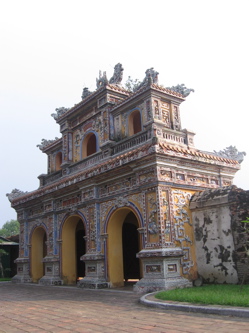 Next morning I was on my way out of rainy Hanoi and off into the jungle heat of Huë. I had no idea this was another climate already since supposedly the great "climate divide" of Vietnam is the mountain range south of Huë and the sudden heat hit me like a brick wall when I climbed out of the plane. Luckily this time the pick up actually was waiting for me at the tiny airport. Much like Da Nang's airport it was built as an US airbase during the war and some concrete hangars housing the US warplanes can still be seen at the far ends, but now it just serves a handful of daily domestic flights.
Next morning I was on my way out of rainy Hanoi and off into the jungle heat of Huë. I had no idea this was another climate already since supposedly the great "climate divide" of Vietnam is the mountain range south of Huë and the sudden heat hit me like a brick wall when I climbed out of the plane. Luckily this time the pick up actually was waiting for me at the tiny airport. Much like Da Nang's airport it was built as an US airbase during the war and some concrete hangars housing the US warplanes can still be seen at the far ends, but now it just serves a handful of daily domestic flights. Realizing that Huë was a lot bigger than I had reckoned, I hired a xe om motorbike taxi to get to the Citadel (yea I admit I loved buzzing around the crazy streets on a bike). The ancient palace of the Vietnamese emperors covered a huge area north of the Perfume River, but sadly the Americans had bombed most of it to shreds in the war after the Vietcong took Huë during the Tet offensive and hid in the citadel. Reconstruction has begun though and more buildings than I had expected were still standing, so I could at least get an idea of what it must have been like. And even the ruins had their own fascination, as I was thinking less of the Vietnamese emperors than of the battles that took place here not so long ago. It was also quite fascinating how empty the grounds were, as long as you avoided the few tour groups that turned up now and then, you had some of the places to yourself.
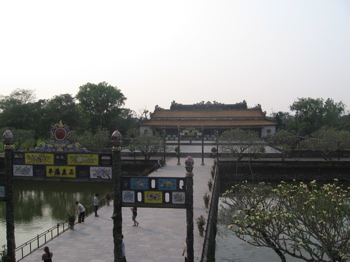 |
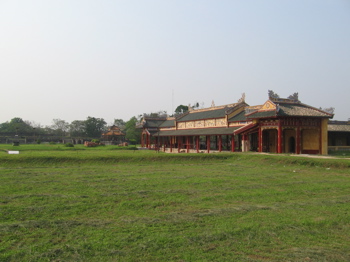 |
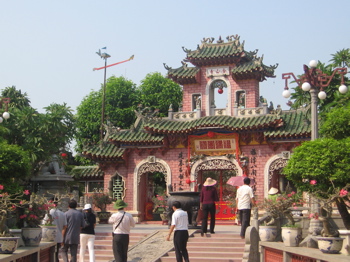 Next morning I had to get up bloody early, though with my internal clock completely out of whack anyway, that didn't matter much. A taxi took me to Hue's station to get on the Reunification Express that runs along the Vietnamese coast, connecting Hanoi and Saigon. Some people use the sleeper carriages to shave a hotel night off their budget, but urgh, having witnessed that the train took a good three hours for the mere 103 kilometres to Da Nang, I'm really glad I bought plane tickets for the longer journeys. Not to mention that the first class carriage was being "entertained" by Vietnamese soap operas on television screens blaring at top volume that not even my mp3-player could drown out.
Next morning I had to get up bloody early, though with my internal clock completely out of whack anyway, that didn't matter much. A taxi took me to Hue's station to get on the Reunification Express that runs along the Vietnamese coast, connecting Hanoi and Saigon. Some people use the sleeper carriages to shave a hotel night off their budget, but urgh, having witnessed that the train took a good three hours for the mere 103 kilometres to Da Nang, I'm really glad I bought plane tickets for the longer journeys. Not to mention that the first class carriage was being "entertained" by Vietnamese soap operas on television screens blaring at top volume that not even my mp3-player could drown out. Picturesque Hoi An is on everyone's sightseeing map but has neither a train station nor an airport, so you need to connect through Da Nang. Having seen that the train station and the bus station are a mile apart from each other (yay for sensible town planning) and my chosen hotel in Hoi An at the other end of town from that bus station, I had decided to fork out $15 rather to have someone pick me up at Da Nang's station - a wise decision. And Hoi An felt like my trip was changing from travelling to vacationing, having booked a hotel with a swimming pool where I chilled a few hours before trudging off into the center whose ensemble of ancient town houses made it on the UNESCO world heritage list. It's very touristy now, with virtually every shop in the tourist trade, most of them tailors that offer to make stuff to measure. While it was tempting, it was still too expensive for my liking, so I made do with a souvenir t-shirt and two Billabong shorts (yes, genuine ones for $5 each, since Billabong is one of the many companies who have their stuff made in Vietnam and some of these make it onto the local market). My hotel offered a happy hour of free cocktails by the pool in the evening, so no guessing where I went for dinner.
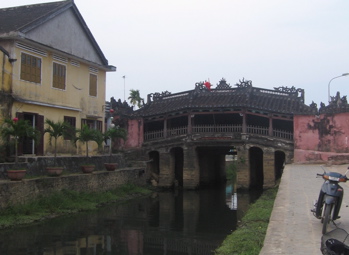 |
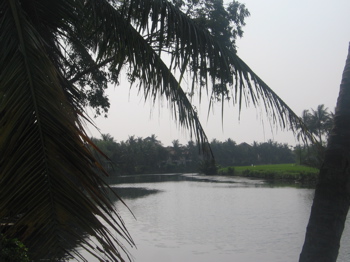 |
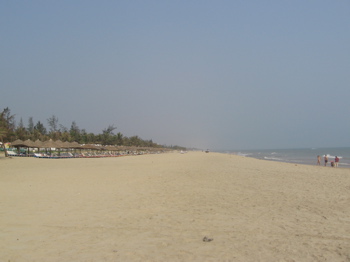 I had planned a day off then, using the proximity of Hoi An to a beach, and not just any beach but a glorious stretch of 10 kilometer long palm-fringed white sand that runs north all the way to Da Nang and was immortalized as "China Beach" during the war, where GIs came for some R&R. Now it's still mostly unspoiled scenery, but the first luxury resorts have started to spring up in the north near Da Nang and the whole area will probably look like Phuket in ten years' time. To get to the beach in Hoi An, I hired a bicycle for the day, which cost me all of 80 Cent and I really enjoyed the ride along the street beachwards, feeling for a brief moment like "I belonged" as virtually everyone in Vietnam is on the move on two wheels, either motorbike or bicycle. I could rent a deckchair and sunshade as well and settled in for some hours of sunbathing, swimming and reading, which was pretty nice, though the sun turned out to be too hot for comfort. I returned to town in the afternoon to treat myself to an hour's Thai Massage, having a 100 lbs Vietnamese girl trampling on me for an hour.
I had planned a day off then, using the proximity of Hoi An to a beach, and not just any beach but a glorious stretch of 10 kilometer long palm-fringed white sand that runs north all the way to Da Nang and was immortalized as "China Beach" during the war, where GIs came for some R&R. Now it's still mostly unspoiled scenery, but the first luxury resorts have started to spring up in the north near Da Nang and the whole area will probably look like Phuket in ten years' time. To get to the beach in Hoi An, I hired a bicycle for the day, which cost me all of 80 Cent and I really enjoyed the ride along the street beachwards, feeling for a brief moment like "I belonged" as virtually everyone in Vietnam is on the move on two wheels, either motorbike or bicycle. I could rent a deckchair and sunshade as well and settled in for some hours of sunbathing, swimming and reading, which was pretty nice, though the sun turned out to be too hot for comfort. I returned to town in the afternoon to treat myself to an hour's Thai Massage, having a 100 lbs Vietnamese girl trampling on me for an hour. I could luckily share transport to the airport in Da Nang with a nice Swedish family, cutting the cost in half and Vietnam Airlines whisked me away to the place of all places: Saigon, most evocative of both the Vietnam war and the French colonial times preceding it. And I am quite relieved that though it's officially Ho Chi Minh City now, everyone still goes with Saigon nonetheless (less of a mouthful and sounding nicer anyway). But after the quiet days in Hoi An and also Hue I was suddenly thrown back into the chaos of a large city, and worse, into the largest traffic chaos known to mankind (at least that's what it felt like to me). I was seriously reeling when I finally made it back to the safety of my hotel room after my first walk around town.
Saigon itself doesn't have all that many sights to see - I passed by the Reunification Palace, the former seat of the South Vietnamese government until the fall of Saigon 1975 and from there to the museum of War Remnants. It's rather small and very one-sided (which is probably to be expected), but it was still the most haunting museum I have ever visited as much of the exhibition consists of photographs of the war, taken by international press photographers (few of who survived the war), photos that were incredibly haunting, poignant and sad, for both sides. Afterwards I headed for Notre Dame Cathedral, hoping it would be cool inside, but no such luck. God heard my prayers though and an air-conditioned Coffee Bean showed up just across the street, so I flopped there for half an hour to revive myself with iced Cafe Latte. I trudged on, down the main shopping street Dong Khoi and saw the opera house and the legendary Hotel Continental, where Graham Greene set a great part of his Saigon spy-novel "The Quiet American".
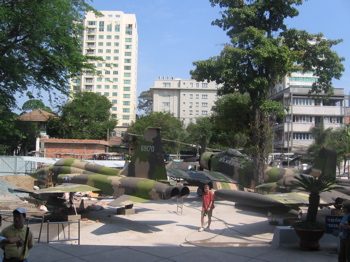 |
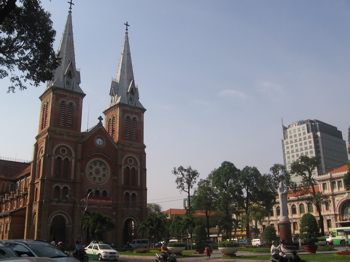 |
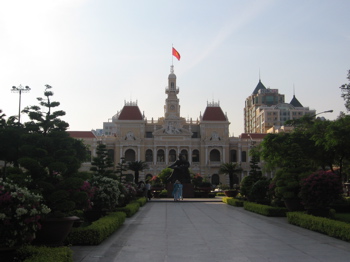 |
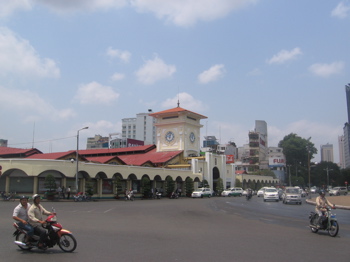 |
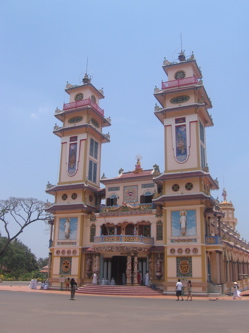 The next two days were spent on day trips, the first taking me northwards, first to the Cao Dai temple then to the Cu Chi tunnels. Actually there are several temples, but this is the big one, it's for this sect what St.Peter in Rome is for the Catholics. Cao Daism is a Vietnamese invention from early 20th century, a fusion of almost all religions known to mankind, mostly relying on Buddhism, Taoism, Confucianism and Christianity that counts Shakespeare and Victor Hugo among their "Saints" (go figure).
The next two days were spent on day trips, the first taking me northwards, first to the Cao Dai temple then to the Cu Chi tunnels. Actually there are several temples, but this is the big one, it's for this sect what St.Peter in Rome is for the Catholics. Cao Daism is a Vietnamese invention from early 20th century, a fusion of almost all religions known to mankind, mostly relying on Buddhism, Taoism, Confucianism and Christianity that counts Shakespeare and Victor Hugo among their "Saints" (go figure). The colorful temple was quite nice to see, especially since we arrived for noon service (well, the tour groups from Saigon time it that way), but more fascinating were the tunnels of Cu Chi, a legendary underground network created by the Vietcong that stretched almost 250 kilometres from the Cambodian border (where the Ho Chi Minh Trail terminated) to Central Saigon, helping the VC not only to sneak around where they pleased (including inside an US base) but to also go completely underground for living, cooking, learning and even hospital treatments.
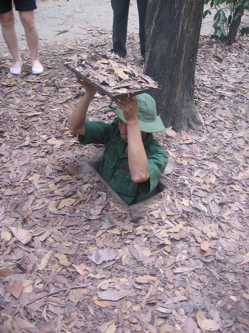 The short stretch of tunnel now accessible has been cleaned up and "enlargened" for the tourists - I honestly don't want to know what the real thing must have been like then (though hey, be fair, your average Vietcong was alot skinnier than the average tourist these days!). More disturbing than the tunnel itself though were the arrays of booby traps that the VC had set up for the Americans all over the area, usually very simple constructions that looked pretty painful nonetheless and would easily send a GI with frayed nerves over the edge. There's also a shooting range where tourists could try the guns and rifles of the war themselves (even including Kalashnikovs!) for a few Dong per bullet. Picture all the guys heading there, eyes bright with excitement, while the women sat around with cans of cold drinks or icecream, shaking their heads.
The short stretch of tunnel now accessible has been cleaned up and "enlargened" for the tourists - I honestly don't want to know what the real thing must have been like then (though hey, be fair, your average Vietcong was alot skinnier than the average tourist these days!). More disturbing than the tunnel itself though were the arrays of booby traps that the VC had set up for the Americans all over the area, usually very simple constructions that looked pretty painful nonetheless and would easily send a GI with frayed nerves over the edge. There's also a shooting range where tourists could try the guns and rifles of the war themselves (even including Kalashnikovs!) for a few Dong per bullet. Picture all the guys heading there, eyes bright with excitement, while the women sat around with cans of cold drinks or icecream, shaking their heads. We came back to Saigon around six and I finally gave myself a nudge and went for Pho, the Vietnamese national dish, which is basically noodle soup with your meat of choice. Hot broth may be yummy in a cold German winter, but yick for soup when it's nearly 40C outside. On the other hand I didn't want to leave Vietnam without having tried it once on location.
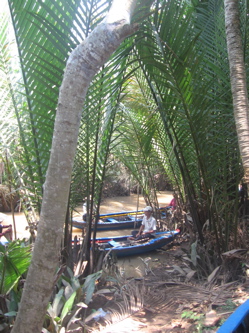 The Mekong Delta excursion took me to the town of My Tho, where we transferred into boats to go to Unicorn Island and were basically led around a tourist trail - visiting a honey farm first, then a place where we "sampled" fresh local fruit and listened to traditional Vietnamese music (no, nobody was torturing the local cats) and a short canoe tour through the canals back to the big boat. We went on to Ben Tre then, to visit one of the places that make "coconut candy" - basically the whole coconut is just churned into sticky sweet goo, a bit like caramel, cooled, cut and packaged... and very yummy. After lunch we had the opportunity to go biking around the island, but I was honestly too tired and lazy in the heat, so I just curled up somewhere to read until it was time to return to Saigon. While I wish I had seen a little bit more of the delta overall and less of the touristy circus, the whole expedition had cost me all of $9 (and yes, that included lunch), so you won't hear me complain. And on returning to the city one of the nicest views I saw in all of Vietnam were all the kids and youngsters on the outskirts and along the river who used the free Saturday to let their kites fly in the sky. And my day wasn't over yet: I had only planned to go out for dinner, but I had been unhappy with my hair for some days now and there was a hairdresser just around the corner of my hotel - offering haircuts for 2 Euro! For an additional Euro I even got a lovely head massage thrown in!
The Mekong Delta excursion took me to the town of My Tho, where we transferred into boats to go to Unicorn Island and were basically led around a tourist trail - visiting a honey farm first, then a place where we "sampled" fresh local fruit and listened to traditional Vietnamese music (no, nobody was torturing the local cats) and a short canoe tour through the canals back to the big boat. We went on to Ben Tre then, to visit one of the places that make "coconut candy" - basically the whole coconut is just churned into sticky sweet goo, a bit like caramel, cooled, cut and packaged... and very yummy. After lunch we had the opportunity to go biking around the island, but I was honestly too tired and lazy in the heat, so I just curled up somewhere to read until it was time to return to Saigon. While I wish I had seen a little bit more of the delta overall and less of the touristy circus, the whole expedition had cost me all of $9 (and yes, that included lunch), so you won't hear me complain. And on returning to the city one of the nicest views I saw in all of Vietnam were all the kids and youngsters on the outskirts and along the river who used the free Saturday to let their kites fly in the sky. And my day wasn't over yet: I had only planned to go out for dinner, but I had been unhappy with my hair for some days now and there was a hairdresser just around the corner of my hotel - offering haircuts for 2 Euro! For an additional Euro I even got a lovely head massage thrown in! 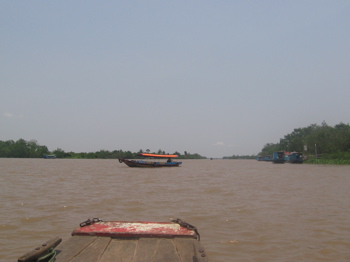 I had another full day in Saigon with nothing much to do, partly because my flight from Da Nang to Saigon had been moved forward by nearly four hours, so I had lots more time on my first day and did the full sightseeing tour, partly because there isn't all that much to see after all. I spent the morning on a long walk to the Jade Emperor Pagoda, tucked away in the north-west of the city, which was smaller than I had thought and full of amazing interesting statues of Chinese ghosts and legends. I returned to the city then for a lovely ice cream in a cafe on Dong Khoi, then went to Ben Thanh Market one last time to buy one of these pretty Sapa bags I liked anyway (and in which I can carry all my stuff home). The afternoon I spent at another spa, where I could get three hours' treatment for $20 - massage, foot massage and a facial. Although it amused me that after each treatment you got a slip of paper where you should tick if you rated it "excellent", "good" or "none", with corresponding tips. Yup, even if you rated it "none", you were still expected to cough up $2! One last stroll around Pham Ngu Lao, one last dinner and a cold beer while watching the bustle on the street, then it was time to say goodbye to Saigon. Glad I've finally been there and it may be interesting to see it change in the next years until it will be another Bangkok, but right now I don't think I'll be back in the near future.
I had another full day in Saigon with nothing much to do, partly because my flight from Da Nang to Saigon had been moved forward by nearly four hours, so I had lots more time on my first day and did the full sightseeing tour, partly because there isn't all that much to see after all. I spent the morning on a long walk to the Jade Emperor Pagoda, tucked away in the north-west of the city, which was smaller than I had thought and full of amazing interesting statues of Chinese ghosts and legends. I returned to the city then for a lovely ice cream in a cafe on Dong Khoi, then went to Ben Thanh Market one last time to buy one of these pretty Sapa bags I liked anyway (and in which I can carry all my stuff home). The afternoon I spent at another spa, where I could get three hours' treatment for $20 - massage, foot massage and a facial. Although it amused me that after each treatment you got a slip of paper where you should tick if you rated it "excellent", "good" or "none", with corresponding tips. Yup, even if you rated it "none", you were still expected to cough up $2! One last stroll around Pham Ngu Lao, one last dinner and a cold beer while watching the bustle on the street, then it was time to say goodbye to Saigon. Glad I've finally been there and it may be interesting to see it change in the next years until it will be another Bangkok, but right now I don't think I'll be back in the near future.
Stop-Over 2: Angkor Wat, Cambodia

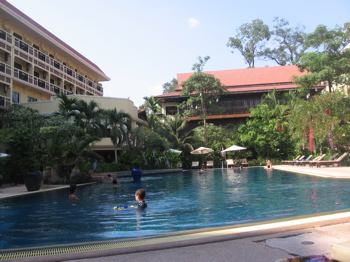 Very early next morning I had to go to the airport for my flight to Siem Reap in neighbouring Cambodia. Amusingly enough I saw the single English lady again who had been on the Mekong Delta trip and we had breakfast together. She had been to Vietnam for 32 days (yikes) and was now on the way to Australia via Bangkok (lucky woman). On the tiny turboprop to Siem Reap (only half-full and all of the passengers tourists) I sat next to a chatty American-Vietnamese who showed me the +600 photos already taken on his camera in Vietnam, including alot of Hue, that made me realize how little I had seen of the whole Citadel area.
Very early next morning I had to go to the airport for my flight to Siem Reap in neighbouring Cambodia. Amusingly enough I saw the single English lady again who had been on the Mekong Delta trip and we had breakfast together. She had been to Vietnam for 32 days (yikes) and was now on the way to Australia via Bangkok (lucky woman). On the tiny turboprop to Siem Reap (only half-full and all of the passengers tourists) I sat next to a chatty American-Vietnamese who showed me the +600 photos already taken on his camera in Vietnam, including alot of Hue, that made me realize how little I had seen of the whole Citadel area. I had picked an upmarket hotel in Siem Reap to spoil myself on this last leg of the journey, the Prince d'Angkor, which was really very pretty with large rooms and a delightful swimming pool. After checking in I was soon on my way to finally fulfill one of my greatest travel ambitions: To see the legendary Angkor Wat, the ruins of the old Khmer metropolis that was the largest town in the world at its height of glory in 14th century.
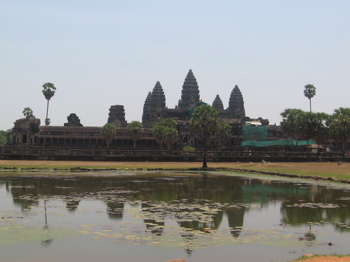 I had thought that renting a bike would be a good idea to get around and it would be - if only more of the roads would be in shadow. But biking in the glaring heat turned out to be just madness. When I got to actual Angkor Wat, the huge temple (and the building you usually see on pictures of the area) I first had a little lunch at the air-conditioned Angkor Cafe to revive myself, then visited the large temple with its famous bas-reliefs and the imposing towers. And thanks to the nice guard who let me climb up the central tower despite wearing a shoulder-free top (a no-no at this religious site) to I could enjoy the view from the top.
I had thought that renting a bike would be a good idea to get around and it would be - if only more of the roads would be in shadow. But biking in the glaring heat turned out to be just madness. When I got to actual Angkor Wat, the huge temple (and the building you usually see on pictures of the area) I first had a little lunch at the air-conditioned Angkor Cafe to revive myself, then visited the large temple with its famous bas-reliefs and the imposing towers. And thanks to the nice guard who let me climb up the central tower despite wearing a shoulder-free top (a no-no at this religious site) to I could enjoy the view from the top. 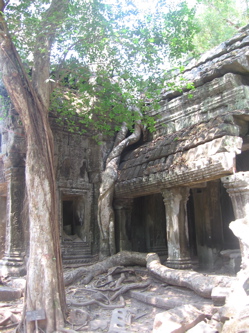 Afterwards I cycled to Ta Prohm, the "sunken city" that looks straight out of Indiana Jones. Or make that "Tomb Raider", because this is where some scenes of the first Lara Croft movie had been shot. The temple is still in ruins, overgrown with trees and has a really unique atmosphere. And I had made sure to be there during the noon hours when the tour groups were stuffing their faces somewhere, so I had Ta Prohm almost to myself - sheer magic, making you feel like a jungle explorer of old who has stumbled across the ruins all alone. It had been a long ride there though and I decided to call it a day afterwards. I returned to the hotel to chill by the pool for a while, then headed into town for dinner and to visit the Old Market to look at Cambodia-style souvenirs (well, more of the same really, with Angkor Beer instead of Saigon Beer on T-shirts).
Afterwards I cycled to Ta Prohm, the "sunken city" that looks straight out of Indiana Jones. Or make that "Tomb Raider", because this is where some scenes of the first Lara Croft movie had been shot. The temple is still in ruins, overgrown with trees and has a really unique atmosphere. And I had made sure to be there during the noon hours when the tour groups were stuffing their faces somewhere, so I had Ta Prohm almost to myself - sheer magic, making you feel like a jungle explorer of old who has stumbled across the ruins all alone. It had been a long ride there though and I decided to call it a day afterwards. I returned to the hotel to chill by the pool for a while, then headed into town for dinner and to visit the Old Market to look at Cambodia-style souvenirs (well, more of the same really, with Angkor Beer instead of Saigon Beer on T-shirts).
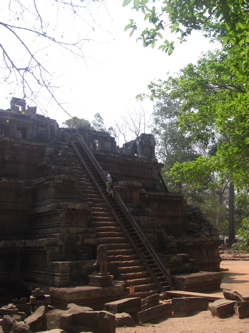 The second day was spent mainly around Angkor Thom, the actual "royal city" built by King Jayavarman VII, though of the actual royal enclosure, made of wood, is nothing left these days. Since it's all rather close together, I didn't bother with a bike, but had one of the tuk-tuk guys at the hotel take me there. The most impressive part of this area is the temple of Bayon with its giant stone faces everywhere looking down at people. One would think it's the face of the Buddha but actually the face looks pretty much like dear old Jayavarman VII. himself... And once more it was impressive how completely alone you were the moment you ventured away from the main track, like I did when I walked away from the royal enclosure to look at small overgrown Preah Palilay, a pretty Buddhist temple not even far away.
The second day was spent mainly around Angkor Thom, the actual "royal city" built by King Jayavarman VII, though of the actual royal enclosure, made of wood, is nothing left these days. Since it's all rather close together, I didn't bother with a bike, but had one of the tuk-tuk guys at the hotel take me there. The most impressive part of this area is the temple of Bayon with its giant stone faces everywhere looking down at people. One would think it's the face of the Buddha but actually the face looks pretty much like dear old Jayavarman VII. himself... And once more it was impressive how completely alone you were the moment you ventured away from the main track, like I did when I walked away from the royal enclosure to look at small overgrown Preah Palilay, a pretty Buddhist temple not even far away. After lunch energy deserted me to venture further afield to look at even more ancient temples - while Angkor is overall an amazing experience, there's only so much I can take, especially in the heat. One poor guy had even collapsed outside the Terrace of the Elephants and was carried back to his group's minivan by two guides amid everyone's stares.
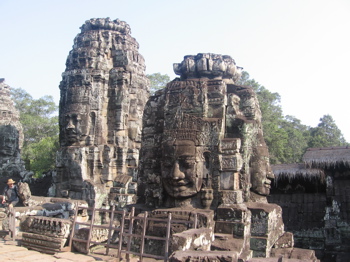 |
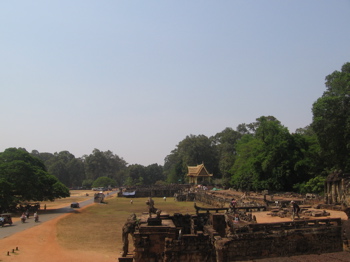 |
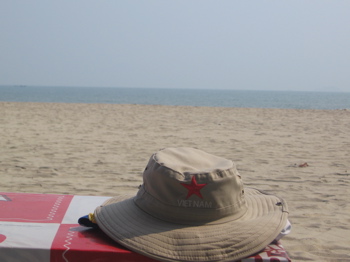
Since my plane didn't leave until late in the next evening I had planned the last day to be a lazy day by the pool side to just chill, recover and decompress from the whole two weeks. It hadn't been the best of times to visit Indochina (apparently the dry season is at its hottest just before the rains begin), but on the other hand it meant low prices and no crowds at the big sights and it wouldn't be all that much cooler in other months anyway.
Most of all I am glad (and a bit proud) that I took the bull by the horns and did venture out there on my own for two weeks instead of remaining at home with a wistful sigh and a I would love to, but... after my potential travel mates had let me down. So what's next after Angkor Wat? Well, I hear there's a nice little place called Machu Picchu awaiting me....
Copyright © All Rights Reserved